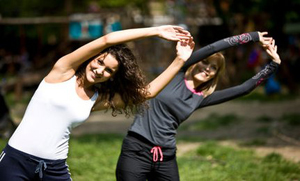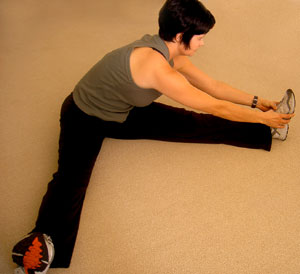 To stretch or not to stretch, that really isn’t a valid question for the runner. Perhaps the runner can ask “When should I stretch?” or “How do I stretch?” but, in my opinion, contemplating whether or not to stretch is a recipe for pain and injury.
To stretch or not to stretch, that really isn’t a valid question for the runner. Perhaps the runner can ask “When should I stretch?” or “How do I stretch?” but, in my opinion, contemplating whether or not to stretch is a recipe for pain and injury.
The task of running is tremendous for the body. The heart works hard, the muscles work hard, the lungs get one of the best workouts possible during a run. While running is so great for a person’s health, it must be noted that all that work really stresses the body as well. After long runs, my muscles get very tight and sore, proving that they need some extra attention before you run on them again.
Stretching can help loosen up tight muscles and allow for more range of motion. Motion on loose muscle verses tight muscles seems to paint an obvious enough picture as to why runners should stretch. A well stretched and flexible runner has the potential to run faster with less effort or training verses the naughty, non-stretcher who knocks out several intense workouts in a week. That fact alone has inspired me to up my stretching game!
While better performance is a great result of stretching, the truth that stretching can help prevent injury is probably the most important reason one must stretch. When muscles are tight and are forced to power the body through a run, a perfect recipe for injury is in the works. From strains all the way to stress fractures, the results of poor flexibility are no joke.
In my experience, I can’t say that one particular time is best for stretching, just as long as it’s happening seems to be the most important factor. Some prefer before a workout, others swear by a post workout stretch session. I find that if I can incorporate stretching throughout the day, I’m better off.
The runner demands a lot from their hamstrings, quads, and calves. These tend to be the most crucial muscles to stretch. However, running asks quite a bit from the rest of the body as well. It’s important to stretch the entire body.
There are many new forms of yoga that are tailored just for the runner. There are other types of flexibility classes available in most gyms and specialty studios too. These are highly recommended and very valuable, but when the schedule doesn’t allow for these classes there are simple options for stretching at home.
This abbreviated list of stretches will cover many of the major running muscles. If I’m pinched for time, I try to make certain I at least do these stretches.
 1. Sitting Hamstring Stretch. This stretch is done by sitting on the floor with upright posture and reaching for the toes. This really stretches out the hamstrings well. It’s important not to strain to reach the toes though. If you can’t reach, just go as far a you can and progress slowly each day.
1. Sitting Hamstring Stretch. This stretch is done by sitting on the floor with upright posture and reaching for the toes. This really stretches out the hamstrings well. It’s important not to strain to reach the toes though. If you can’t reach, just go as far a you can and progress slowly each day.
2. Wall Leaner Calf Stretch. To get a great calf stretch, stand facing a wall with your feet a few feet away. Put your hands on the wall and keep your heels on the ground. Lean forward with the hips and feel the stretch.
3. Heel Hold. You can use the wall you just leaned on to steady yourself with one hand and with the other hand grab an ankle. Pull that heel up against the buttocks. Obviously, repeat with the other leg. The quads will really benefit from this stretch.
4. Butterfly. The butterfly is done by sitting on the floor with good posture and your legs pulled together so the soles of the feet are touching. With the knees pointing to each side, wrap your hands around your feet and stretch the legs downward towards the floor. This will stretch the muscles in the groin area.
I’ve been told my stubbornness towards stretching is common among runners. I struggle with the idea “more work” after I’m already putting in so much effort with the running alone. However, after I’ve sustained enough injuries that have been directly linked to my lack of flexibility, I’ve had to retrain my thoughts about the task of stretching. I will pass on the same advice that I was given, “You must learn to love stretching.” Fake the love if you have to, even curse it while you’re doing it, just make sure you stretch.
Also Read:
Practice a Stretching Regimen for Flexibility and Injury Prevention
